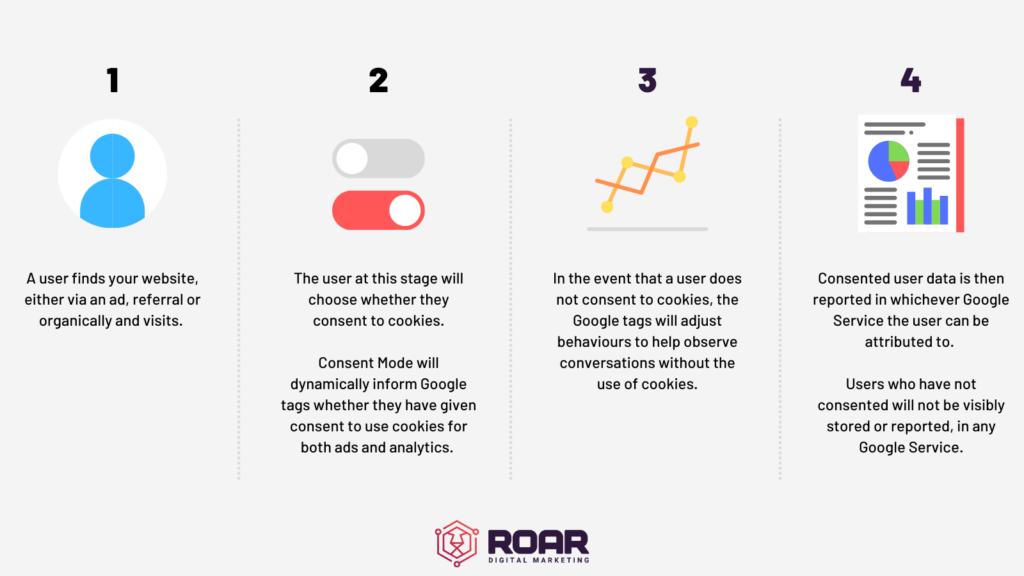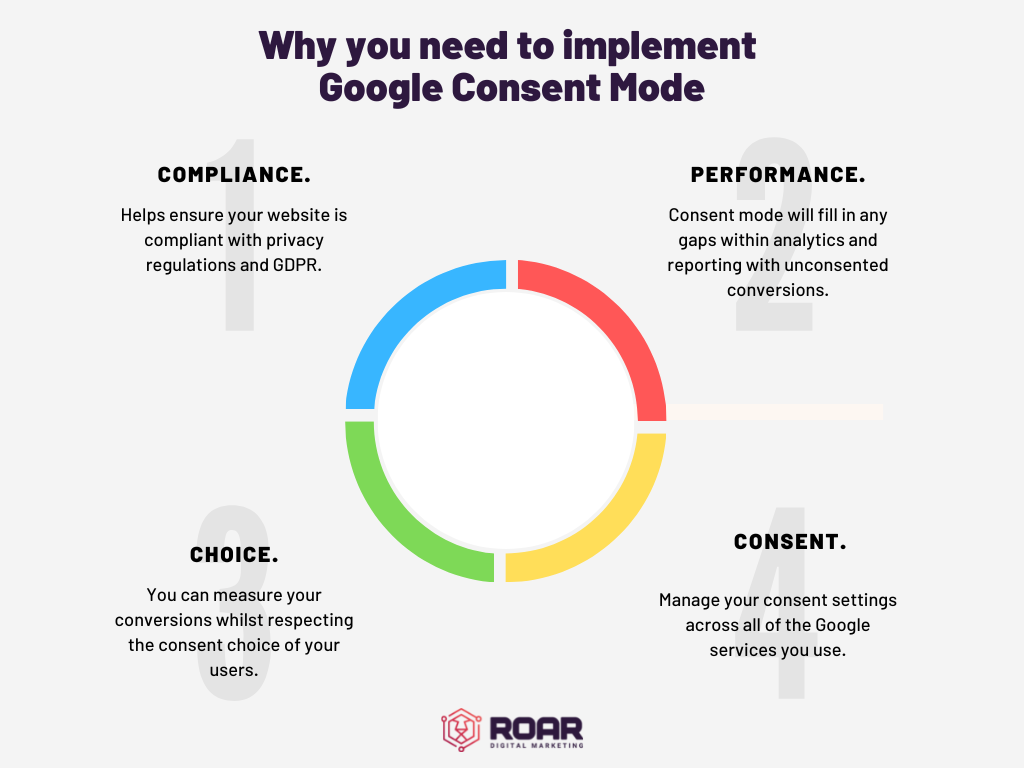
-
Joshua Lee
- 5 Min Read
- Blog, Google Updates
What is Google Consent Mode?
It’s been a long time coming, but we’re in the endgame now. Google is slowly introducing their Consent Mode to tackle data privacy and user consent. But what does this mean for the Digital Marketing industry?
What is Google Consent Mode?
While Google Consent Mode officially launched in September 2020, it has gone through a number of evolutions since then. In its inception and launch, it was a feature of Google’s search engine and marketing and advertising arm with the intent of keeping themselves compliant.
Having been born during a period of vast amounts of personal data breaches, it seemed inevitable that it would evolve in some form or another. Something this valuable was destined for more.
Its newest form is that of an application programming interface or API for short. Organisations across the world with a presence online can continue to use their favourite Google gadgets and platforms while ensuring that they are GDPR compliant and in line with Data Privacy Law.
To many in digital marketing, this is either the end of it all or a fresh, new beginning where the often arduous task of keeping their marketing efforts compliant comes to an end. Businesses who are already compliant will be able to continue their existing marketing efforts, and won’t be in fear of Google. Businesses lagging behind, however, should be very wary of Google.
So, in short, everyone using Google’s services can now prioritise user consent and privacy without too much bother! The data collected through Google services will be based on the consent of the user.
How does Consent Mode Work?
Google consent mode effectively works as a website measurement solution for websites and for Google products. For a website, it will provide guidance and recommendations in order to keep the business compliant with the consent of website users. For Google services, it will act as an overarching adjustment to the behaviour of a user’s consent choices. Most notably:
- Google tags on Google Tag Manager.
- User actions with Google ad campaigns.
- Pretty much everything is on Google Analytics.
- Floodlight (this is Google’s conversion tracking system, for pretty much everything)
Okay, let’s look at an example that should be pretty universal to all businesses online. A user lands on your site, and your cookie policy pops up; this is where consent mode comes in.
Previously, regardless of the user’s decision, their activity would still be able to track them and collect information about their behaviour and actions on the site. In this way, the responsibility fell on the website owner to be compliant with the data collected through Google services.
With Consent Mode implemented on all Google services, it is the user’s decision that will now inform whether the business can track the user’s behaviour. If the user gives their consent and fully accepts your cookie policy, then it’s smooth sailing from here on out! If they do not consent, conversions will still fire as expected and be collected by Google services, but you won’t be able to see it as a recorded conversion.
Anyone that has set up tags on Google Tag Manager will understand how much time this will save! No more complex and detailed firing conditions and hullabaloo about consent and privacy. It’s almost enough to bring a tear to the eyes of our SEO team!
Why you need to Implement Consent Mode
Have you been paying attention? Then this section should really answer itself. Truthfully, there is a little bit of manual action needed to implement Consent Mode. But the real implementation we’re referring to is aligning the changes made to Google services within your marketing efforts.
Right, so here’s the tricky part of getting your head around it. Consent Mode doesn’t necessarily take away non-consenting users’ data from your analytics and reporting but just makes it anonymous.
So, let’s say you’re currently GDPR compliant, and you have tags set with Tag Manager and a cookie policy pop-up that determines user consent status. If a website user does not consent, you have absolutely no way of benefitting from these conversions, and they’re lost forever. You can only benefit from them and store their behavioural data in your analytics platform of choice if they have consented.
Google Consent Mode, on the other hand, allows the opportunity to benefit from the anonymous data collected, whether consent is granted or denied.
For example, conversion modelling in Google search ads uses this anonymous data to make better informed data-driven modelled conversions. Conversion modelling has been available since 2021, so you might have already seen modelled conversions pop up in both the conversions and conversions value columns.
Modelled conversions fill in the gaps after users opt out of cookie policies but engage with the ad and actually convert as a result. A phantom-like conversion that, although is ethereal and can’t be touched or seen still provides some benefit.
Why do you need to implement Consent Mode? Well, it’s the same old song and dance, Google says ‘jump’, and you say ‘how high’. Get up to date as quickly as you can so you’re not coughing the exhaust fumes of the Google party bus as your competitors drink champagne in air-conditioned luxury.
What challenges does it present?
Apart from the obvious, Consent Mode presents more opportunities for business than challenges. The initial, obvious challenge would be the hurdle of knowledge and time. Most small businesses won’t have the time or resources to come away from a blog like this one and immediately crack on. The immediate challenge is understanding Consent Mode and knowing how to benefit from it.
So, initially, it doesn’t present a massive challenge, but with any new guidelines and technology changes, there are bound to be some teething issues and hurdles.
How to Start Using Google Consent Mode
At this point, we want to stress that this is not where your data privacy and consent efforts should start and finish. While Consent Mode can help make your website compliant, how you store your data, share your data, and how you collect will not be covered by Consent Mode.
A lot of businesses are investing in what is called a consent management platform or taking the time and investing some resources in ensuring compliance with GDPR.
For a full, comprehensive guide to implementing Consent Mode, take a look at this dev guide from Google.
Key points to Takeaway
To get a more in-depth view of how Google Consent Mode works check out the blog – Google Consent Mode Explained
Are you using Google services? Then Consent Mode is incredibly important. A little bit of pain for the long-term benefit, get it over and done with now and reap the benefits later on.
We’ve learned that:
1. Consent Mode is an application programming interface designed to help ensure that websites are GDPR compliant. Just a website, Consent Mode will not make a business compliant with GPDR and Data Privacy Law.
2. It requires a bit of manual action to implement, but nothing out of the scope of a web developer or tech-savvy digital marketer.
3. Data collected on Google Services from users that do not consent to cookie policies will not be collected but, in some cases, listed as anonymous. It will be used to improve things like conversions modelling.
ROAR’s team of SEO specialists can provide a fresh pair of eyes to your current digital marketing strategy. Let’s get your marketing engine running again with our digital strategy consultancy.
Interested? Speak to one of our specialists today and book a free consultation.







